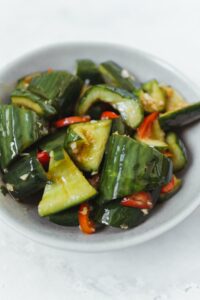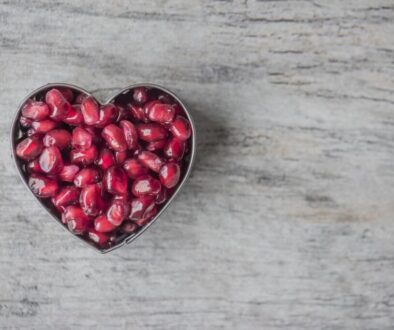TCM Food Energetics for Health
There is an episode of the comedy TV show Friends where Rachel made a trifle for holiday dinner. Trifle is a dessert with lady fingers, jam, custard, and berries. But, this version also included layers of meat and peas from Shepherd’s Pie. (Rachel misread the recipe because pages were stuck together.) Her friends then tried in various ways to avoiding telling her about her mistake, afraid they would ruin the holiday meal.
I was reminded of that episode when I read the following article: What foods shouldn’t be eaten together according to Traditional Chinese Medicine?. The article explains how in Chinese Medicine, foods are classified by their energetic properties. In this article they discussed only the property of temperature to keep it simple.
TCM energetics of food and herbal medicine classifications include:
- Flavors (sweet, salty, sour, bitter, spicy)
- Temperatures (hot, warm, neutral, cool, cold) and
- Meridians and Organ Systems each food affects
The article also discusses why certain foods and food combinations are good for some people, but not for others. In modern thought, foods are simply combinations of molecules and nutrients, and for the most part there are no significant guidelines about how they interact with each other, outside of how their flavor combinations affect taste and molecules affect nutrition.
The article explains why we should pay attention to how we combine foods. If we don’t, it could lead to issues like digestive upset, or it could aggravate an existing health issue such as IBS, hemorrhoids, or skin-diseases such as psoriasis, or acne.
In some dishes, combining ingredients balances the energetics of the foods, and makes it safe for (most) anyone to eat. In other cases, the food combinations have a specific purpose for being eaten during that season, in that climate, or for a person’s constitution.
For example, you don’t typically see people reaching for watermelon after a day of sledding or snow-skiing. Hot warming foods, including cinnamon, ginger, cloves or other warming spices is more likely to be chosen (mulled apple cider with cinnamon and cloves). Watermelon is a cooling and moistening food, and would be great after a hot day working, sweating or playing in the sun.
 Hot fried foods warm the body.
Hot fried foods warm the body.
Skin conditions such as acne, eczema, and psoriasis are affected by foods. For example, these conditions can be caused by, as well as aggravated by eating hot-damp foods. For example, combining alcohol and fried foods will worsen skin conditions with redness, or pus.
This is why I will send some patients home with a food-log, so that they can give me an idea of what a typical week’s diet is like, and if they are willing, we can work together to begin their healing by adding or deleting certain foods from their diet.
The article also discusses foods appropriate for each body constitution. (ie: Are you generally running warm, or cold, or is your body damp, or dry, etc.) TCM principles are based on ancient observations that the patterns found in nature will also occur in your own body. So the typical pattern of someone in Seattle living in cool, damp weather won’t be the same as someone who lives in Phoenix, or LA which is warmer and drier. My colleagues in these cities have confirmed that the typical patients in a cold-damp climate often do not have the same patterns as ones who live in hot-dry climates (as a general rule).
 Cool vegetables balanced with hot chilis.
Cool vegetables balanced with hot chilis.
Black coffee is hot and bitter and drying. It is the perfect damp-draining drink for a rainy Seattle day. But adding milk or a sweetener will generate dampness, thus reducing or blocking the drying effects.
Though nowadays, in modern life, a problem with generalizing about these conditions is that we all live indoors year-round in spaces that are conditioned to keep us at room temperature (68-75). Our bodies aren’t as affected by, and don’t adapt to the external environment as much as we used to be when we spent more time outdoors, or before central heating and cooling. Instead, often our patterns come from being over-fed, and under-exercised as a general rule – this leads to a phlegm-damp constitution with stagnation (which can be either heat or cold depending on how it evolved in that person). In modern industrialized society, we tend to eat mostly sweet and salty flavors (with a little spicy for some people) but very little bitter and sour foods. So we are unbalanced with excess dampness in the body (leading to digestive disorders, fungal overgrowth, obesity, skin diseases, and more.)
Bitter gourd is a vegetable that is known to help with blood sugar regulation. By itself it is pretty much too bitter to eat, but prepared with other herbs and spices, and cooked, will be quite delicious.
If you are interested in learning a bit more, some resources for food energetics can be found in the following books:
(This is purely a reference book with tables of food categories.)
https://www.amazon.com/Helping-Ourselves-Traditional-Chinese-Energetics/dp/0952464004/
(This is more of a manual for healing which also contains information on food energetics.)
https://www.amazon.com/Healing-Whole-Foods-Traditions-Nutrition/dp/1556434308
This method of food combining may not be as obvious as knowing not to combine your trifle with ground-beef onions and peas, but I hope it opens to door to understand the importance of the energetic qualities of what you are eating and that it affects your body in ways you weren’t previously aware of.
To find out what happened to the trifle after she made it, see the rest of the scene here.


